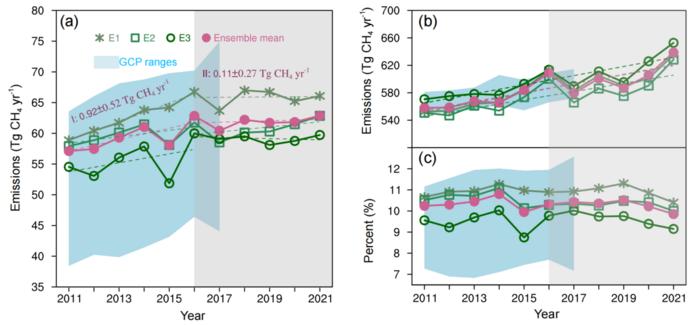Methane is a potent greenhouse gas. Since the Industrial Revolution, atmospheric methane concentrations have nearly doubled, with its radiative forcing accounting for one-third of all greenhouse gases. As one of the world’s largest methane emitters, China made a clear commitment as early as 2007 to “strive to control the growth rate of methane emissions.” The country’s 12th, 13th, and 14th Five-Year Plans all proposed measures to control methane emissions. In 2023, China released the “Methane Emission Control Action Plan,” which provides a comprehensive strategy for controlling methane emissions.

Credit: ©Science China Press
Methane is a potent greenhouse gas. Since the Industrial Revolution, atmospheric methane concentrations have nearly doubled, with its radiative forcing accounting for one-third of all greenhouse gases. As one of the world’s largest methane emitters, China made a clear commitment as early as 2007 to “strive to control the growth rate of methane emissions.” The country’s 12th, 13th, and 14th Five-Year Plans all proposed measures to control methane emissions. In 2023, China released the “Methane Emission Control Action Plan,” which provides a comprehensive strategy for controlling methane emissions.
Accurately quantifying methane emissions and their contributions from various sectors is crucial for tracking changes in emissions and assessing the effectiveness of reduction measures. The “Methane Emission Control Action Plan” comprehensively calls for the strengthening of methane monitoring, accounting, reporting, and verification systems. China’s methane emission accounting started late, with a weak foundation, and there is an urgent need to enhance emission control and monitoring capabilities. In the past, the international community generally believed that China’s methane emissions had a significant impact on the global increase in methane concentrations. However, the latest research from the Institute of Tibetan Plateau Research, Chinese Academy of Sciences, indicates that since 2016, the growth rate of China’s methane emissions has significantly slowed, and its contribution to global methane emissions is decreasing. This research was published in the National Science Review under the title “Slow Down in China’s Methane Emission Growth.”
This study, based on China’s independent global atmospheric inversion system “GONGGA”, successfully developed the GONGGA-CH4 system, which boasts high inversion accuracy and low computational cost. Using this system, GOSAT satellite methane column concentration observations were assimilated to systematically assess global and China’s methane emissions from 2011 to 2021. The results revealed that China’s methane emission growth significantly slowed from 2016 to 2021 (0.1±0.3 Tg CH4 yr-2), in stark contrast to the higher growth observed from 2011 to 2015 (0.9±0.5 Tg CH4 yr-2). Meanwhile, global methane emissions accelerated during the same period (2016 to 2021) (Figure 1).
Compared to previous inversion methods, the GONGGA-CH4 atmospheric system distinguishes major methane emission sectors using a unique 4DVar regularized multi-factor joint inversion technique. The study’s results indicate that the reduction in agriculture and wetland emissions is the primary reason for the slowdown in China’s methane emission growth (Figure 2). Previous studies generally estimated that methane emissions from China’s rice paddies accounted for about 30% of global rice paddy emissions, with straw return measures leading to increased methane emissions from rice fields. However, the GONGGA-CH4 system’s inversion results provide a different perspective: as most rice paddies have achieved stable straw return in recent years, the rice planting area has become the main driver of changes in methane emissions, with its decrease leading to a reduction in agriculture methane emissions since 2016. Furthermore, the study found that the drier climate conditions in southern China in recent years have significantly reduced wetland methane emissions. This contrasts sharply with the rising methane emissions trend in tropical regions globally, further highlighting the substantial regional differences in the impact of climate change on methane emissions. However, the study also noted that although China’s coal mine methane emissions briefly decreased following the implementation of the “shutdown of small coal mines” energy policy, recent increases in energy demand have led to a significant rise in coal methane emissions. This underscores the ongoing challenges China faces in controlling methane emissions.
Dr. Zhao Min, at the Institute of Tibetan Plateau Research, Chinese Academy of Sciences, and the first author of the paper, explained that due to methane’s relatively short atmospheric lifetime (about 10 years), reducing methane emissions is considered a quick and effective means of mitigating global warming. The successful development of the GONGGA-CH4 system lays a solid foundation for China’s active participation in the Global Carbon Project’s methane emission assessments in the future. This is crucial for achieving the goal set by the Paris Agreement to limit global temperature rise to below 1.5 ℃.
The findings were published online on June 26, 2024, in the National Science Review. The study was co-corresponding authored by Researcher Xiangjun Tian and Associate Researcher Yilong Wang. This research was supported by the Second Tibetan Plateau Scientific Expedition and Research Program (2022QZKK0101), the National Natural Science Foundation of China (41988101, 41975140, 42001104), and the Young Scholars Innovation Program of the Key Laboratory of Earth System and Resources Environment of the Tibetan Plateau (TPESER-QNCX2022ZD-01).
Journal
National Science Review



